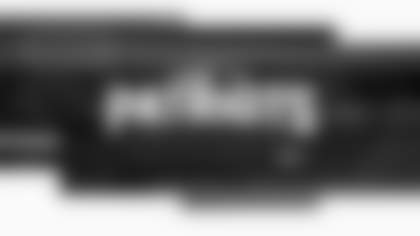Patriots head coach Mike Vrabel's biggest hire for his coaching staff was offensive coordinator, which Vrabel filled by hiring longtime OC Josh McDaniels for his third stint in New England.
However, the defensive-minded Vrabel also must fix a Patriots defense that finished the 2024 season ranked 30th in DVOA and 22nd in scoring defense (24.5 PPG), following a season where they were ninth and 14th respectively in 2023. New England's defensive drop-off after parting ways with former head coach Bill Belichick was well documented. One could argue that improved health will spark internal growth from this side of the ball. Still, the Patriots new coaching staff has work to do to get the unit back on track next season.
Along with Vrabel being a leading voice in the Patriots defensive philosophy, the Pats HC tabbed veteran defensive line coach Terrell Williams as his defensive coordinator. Williams is lauded as one of the top D-Line coaches in football, with his last boss in Detroit, Dan Campbell, saying that Williams is the best defensive line coach in the NFL. Despite injuries mounting for the Lions, Detroit's defense was still a respectable 11th in pressure rate and 10th in rush DVOA, with Williams coaching up the defensive line and holding the title of run-game coordinator.
Plus, the Patriots new DC was on staff for all six seasons that Vrabel was Titans head coach, including the final year when Williams was Vrabel's assistant head coach. After a season where New England's defense ranked 29th in pressure rate and 28th in rush DVOA, having a trusted defensive line guru to improve the play in the trenches should help.
That said, Williams has never been a primary defensive play-caller. Although he has nearly three decades of coaching experience and has been in the NFL since 2012, that aspect is an unknown for Williams. It also brings into question how much input Vrabel could have in defensive play-calling. With an experienced offensive coordinator in McDaniels, Vrabel, a former DC himself, could help Williams transition into that role.
Until we see them in action, it's unclear what elements of the Titans and Lions defenses Vrabel and Williams could run in New England. It's worth noting that Vrabel's last defensive coordinator in Tennessee, Shane Bowen, is remaining with the Giants as their coordinator. At the same time, Detroit ran a blitz-man scheme under new Jets head coach Aaron Glenn. In other words, we don't know what Vrabel and Williams will do with the Patriots defense, so all we can do is make an educated guess based on what the Pats defensive brain trust did together in Tennessee.
After reviewing tape from Vrabel's last few seasons with the Titans, the biggest takeaway was that Tennessee predominantly ran fronts with four-down defensive linemen (4-2-5 nickel). On the whole, the Pats were a three-down, or odd front, base defense in a 3-3-5 nickel grouping under former head coach Jerod Mayo and Coach Belichick. If the Pats new coaching staff shifts to an even front base, that'll be a departure from the Belichick-Mayo years.
The Titans primarily played with one-gapping mechanics against the run as an even front scheme. Tennessee's early-down base front was an over front. On the interior, the D-Line has a three-technique (shaded over the guard in the B-Gap) and a nose tackle lined up in the opposite A-Gap (one-technique). The other constant for the Titans was playing with wide hand-in-the-dirt defensive ends, either in a nine or seven technique. With defenders playing a single gap vs. the run rather than two-gapping like New England has done historically, this is more of a penetrating defensive front rather than holding the point of attack.
Along with playing single gaps to stop the run, the Titans also featured early-down creeper pressures and backend disguises. Creepers are when an unexpected rusher, like a defensive back, blitzes while a defender in a pass-rushing position drops into coverage. Tennessee dialed up a creeper pressure on 3.7% of their plays in 2023, the 11th-highest mark in the NFL, per NextGen Stats. According to former Patriot and Titans great Logan Ryan, simulating pressure was a strength of the Titans scheme.
"We did a lot of complicated secondary pressures, blitzes, stuff to make it hard on the quarterback because we had a really smart, veteran secondary. We found a way to simulate pressure. We found a way to be multiple and complicated," Ryan told Patriots.com.
In this example, the Titans bring a nickel blitz from the right side of the formation and drop the defensive end off the line of scrimmage that's over the left tackle. Then, they spin or "buzz" the backend to have the deep safety replace the slot corner in the short zone distribution. The coverage ends up being a single-high cover three zone, with the slot blitz producing a free runner at the quarterback, and Tenneessee forces an incomplete pass.
On obvious passing downs, the Titans continued to play with four-down linemen. However, they'd shift to either overload a side with three defensive linemen to one side of the center or widen the front to play with two wide-nine rushers and two three-technique rushers.
Here is an example of Tennessee's third down plan against the Dolphins, now a divisional opponent this staff will face twice a year. The Titans overload the right side of the offensive line and run a three-man stunt as they often did to stress the protection. The Titans play cover-one robber in the backend, with man-to-man coverage aided by post-safety and robber help. The stunt gets home to apply pressure on Tua, and the pass is nearly intercepted.
The benefit of transitioning to a four-down defense is that it tends to be more aggressive. Rather than reading and reacting to run or pass, the defensive line is unlocked to get upfield, leading to more plays behind the line of scrimmage. Last season, the Pats struggled to generate early-down pressure, ranking 31st in pressure rate on first and second down. In theory, this style of play could lead to more negative plays.
The potential downside is that it can sometimes be boom-or-bust against the run, while there are personnel questions worth asking. One could see DT Christian Barmore thriving in a Jeffery Simmons-type role as a penetrating three-technique, while the upfield nature of the scheme could also benefit third-year DE Keion White. However, career two-gappers might not have a place in this defense. Along those lines, the Patriots would probably need to target defensive ends this offseason who specialize in getting up the field rather than holding the point of attack.
There's also a conversation about the types of linebackers that fit this scheme. Typically, even front defenses feature athletic linebackers like 49ers star Fred Warner or All-Pro linebacker Matt Milano in Buffalo. Inside linebackers can be put in high-stress coverage assignments in this defense and asked to blitz, while it helps to have sideline-to-sideline range to chase down the ball carrier effectively. Simply put, the mechanics often force the ball outside (spill), where an "overlap" defender will wrap around to make the tackle. Therefore, it helps to have linebackers that move well laterally to close down that space.
Ultimately, there's a level of faith in Vrabel and Williams to adapt the scheme to the personnel. If they feel it's in the Patriots best interest to stick to odd fronts, they probably will, and the same goes for their coverage splits favoring man coverage. The guess here is the Pats coaches won't be married to one style of defense, playing to All-Pro CB Christian Gonzalez and others' strengths by playing man coverage.
From this perspective, the Vrabel-Williams duo turning the Patriots defense into a more aggressive unit is enticing. With how often teams pass nowadays on early downs, quickly transitioning from a run defender to a pass-rusher in a two-gapping system is challenging. Oftentimes, it seems to stymie New England's early-down pass rush. The goal for a two-gapper is to build a wall by pressing the blockers and then mirroring the ball carrier. When it's a pass, it becomes a game of read, react, and transition into a pass rusher, which takes time.
During his introductory press conference, Coach Vrabel made a point to mention the importance of "affecting the other team's quarterback" to be a winning football team.
"When you look at statistically what wins in the NFL, our ability to affect the other team's quarterback and our ability to provide for an efficient quarterback and passing game is a high contributor to success," Coach Vrabel said.
Based on his opening remarks and what this defensive brain trust has done in the past, the Vrabel-Williams scheme might look different than recent Patriots defenses.
DISCLAIMER: The views and thoughts expressed in this article are those of the writer and don't necessarily reflect those of the organization. Read Full Disclaimer








































